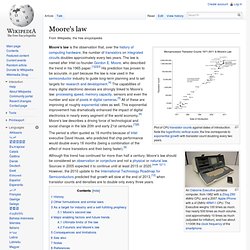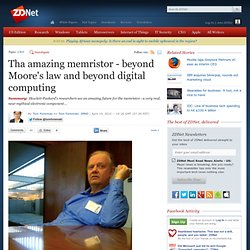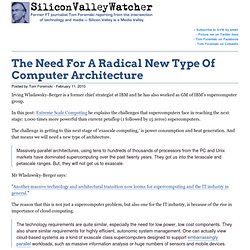

Moore's law. Moore's law is the observation that, over the history of computing hardware, the number of transistors on integrated circuits doubles approximately every two years.

The law is named after Intel co-founder Gordon E. Moore, who described the trend in his 1965 paper.[1][2][3] His prediction has proven to be accurate, in part because the law is now used in the semiconductor industry to guide long-term planning and to set targets for research and development.[4] The capabilities of many digital electronic devices are strongly linked to Moore's law: processing speed, memory capacity, sensors and even the number and size of pixels in digital cameras.[5] All of these are improving at roughly exponential rates as well.
This exponential improvement has dramatically enhanced the impact of digital electronics in nearly every segment of the world economy.[6] Moore's law describes a driving force of technological and social change in the late 20th and early 21st centuries.[7][8] History[edit] Tha amazing memristor - beyond Moore's law and beyond digital computing. I recently visited HP Labs and spoke with Stan Williams, senior fellow at Hewlett-Packard and director of Quantum Science Research, about an incredible semiconductor device -- the memristor.

Until fairly recently, the memristor, short for memory resistor, was a mythical electronic component. It had been predicted to exist by a mathematician, Leon Chua, a professor at UC Berkeley, in an 1971 paper. No one had made a memristor until Stan Williams and his team cracked it in 2008. The memristor can: - store data like DRAM or Flash but it doesn't require any energy to maintain the data storage. - the memristor chips can be laid down in layer upon layer upon layer, creating three-dimensional structures that can store and process data. - the memristor is easy to make and completely compatible with today's CMOS chip making processes. - it can be scaled to very small geometries without losing its properties. - the memristor can also perform logic, it can act as a microprocessor! The Need For A Radical New Type Of Computer Architecture. Posted by Tom Foremski - February 11, 2010 Irving Wladawsky-Berger is a former chief strategist at IBM and he has also worked as GM of IBM's supercomputer group.

In this post: Extreme Scale Computing he explains the challenges that supercomputers face in reaching the next stage: 1,000 times more powerful than current petaflop (1 followed by 15 zeros) supercomputers. The challenge in getting to this next stage of 'exascale computing,' is power consumption and heat generation. And that means we will need a new type of architecture. Massively parallel architectures, using tens to hundreds of thousands of processors from the PC and Unix markets have dominated supercomputing over the past twenty years. Mr Wladawsky-Berger says: "Another massive technology and architectural transition now looms for supercomputing and the IT industry in general. " The reason that this is not just a supercomputer problem, but also one for the IT industry, is because of the rise in importance of cloud computing. Qubits and Defining the Quantum Computer"
Quantum computer. Study of a model of computation Quantum computing is the use of quantum phenomena such as superposition and entanglement to perform computation.

Computers that perform quantum computations are known as quantum computers.[1]:I-5 Quantum computers are believed to be able to solve certain computational problems, such as integer factorization (which underlies RSA encryption), substantially faster than classical computers. The study of quantum computing is a subfield of quantum information science. There are several models of quantum computing, including the quantum circuit model, quantum Turing machine, adiabatic quantum computer, one-way quantum computer, and various quantum cellular automata. The most widely used model is the quantum circuit. There are various approaches to implementing quantum computers, for example quantum simulation, quantum annealing and adiabatic quantum computation.
Quantum operations[edit] A memory consisting of bits of information has possible states. And or. . , and . .